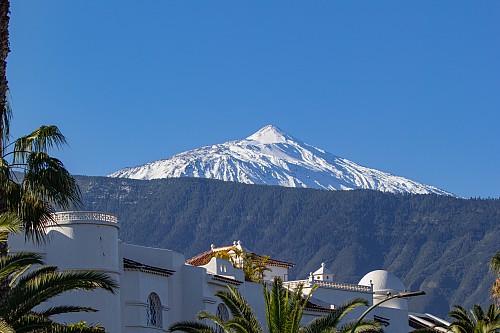
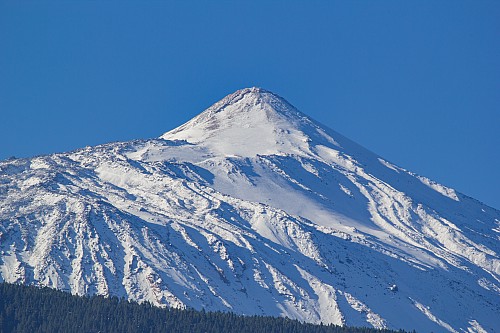
The first couple weeks together in our new home were quite nice, and it didn’t take us very long to get used to our new normal. Every weekday we would have Spanish class from 09:00-12:15. On those days we had a fairly standard morning routine. We’d get up sometime between 07:00 and 08:00, and we hardly ever were still asleep when our alarm would’ve gone off. We’d leisurely wait to get up, and usually Avon needing to pee was usually was the catalyst. On the first or second night we let him on the bed, he peed all over it, and he lost all his privileges, so he slept in his crate, and Lola slept on a dog bed that we bought her just for sleeping (when she was wearing her diaper, which we put on immediately before we got in bed). After getting up, we’d let the dogs outside, feed them, and clean up after them once they used the facilities on the lawn.
We’d head over to school at around 08:50. Our walk to school consisted of walking out our personal front gate, turning right, walking down the sidewalk to the big front gate to the complex, going out that, turning left, walking past the entrance of the botanic garden, and then crossing the carreterra. Right at the corner of the carreterra and Calle Retama the sidewalk was exceedingly narrow, so if someone was coming the other way around the corner, we’d have to stop and let them go first. This happened maybe 1 out of every 25 times, as it wasn’t particularly busy. About 80% of the time, as we'd turn out onto Calle Retama, there would be two older men, walking their three small dogs - this was obviously their routine as well. The intersection of the Carretera and Calle Retama/Calle Camelia had some of the only car horn honking we ever heard in Puerto. While no one ever seemingly honked elsewhere in town, if anyone tried to turn left off of Calle Retama or Calle Camelia, rather than go straight through the intersection as required, horns would blare in short order. There wasn't ever an accident, and it was sort of comical (to us), but I'd be interested to know why this particular intersection got famous for horn honking.
 |
 |
At school, I was in an A2 class, and Crystal was in A1. My original class consisted of two people from France (a Caucasian woman and a man of Chinese descent), a woman from Belgium, and a couple people from Germany. My teacher, Sandra, was born and raised on Tenerife, and lived one town over. The class was entirely in Spanish, and really strained my ears, as there was no “easy” part where I could coast. As the weeks went by, the mix of people in class changed, as new people joined and some dropped off. There would be a break around 10:30, and theoretically it was supposed to last only until 10:45, but most days it went longer, with us just chit-chatting in the courtyard (top left photo below). Crystal would use the time to walk a lap around the school on Camino de la Garañona, Calle Luis Rodriguez Figueroa, and Calle Camelia. Everyone in class was very nice and supportive, and Sandra was exceedingly patient with all of us and kept a familial vibe in the classroom. While there was an arranged curriculum, if there was a topic where the students were interested in talking and interacting with each other, she was more than willing to go off onto those tangents and get people talking, listening, asking questions of each other, etc. Every morning she would ask us what we did the day before (after class), and we got practice at speaking in the past tense in the process. We also spoke quite a bit in class about places to eat and things to eat, as that was a popular topic for everyone.
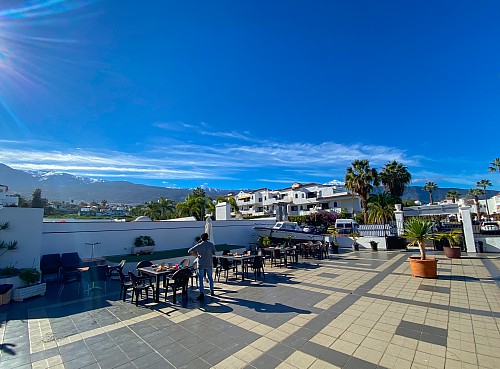 |
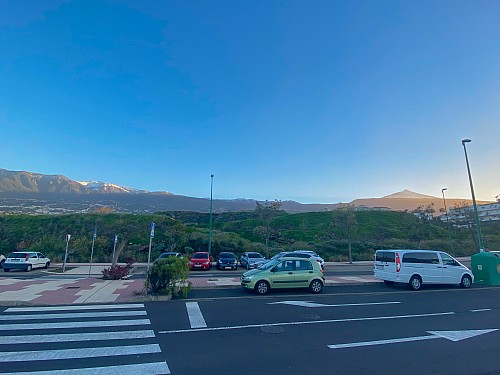 |
When class would end at 12:15, I’d meet Crystal and we’d either walk directly to lunch with our textbooks, or we’d walk home quickly, drop off our stuff, and then go to lunch. While sometimes we would eat nearby in La Paz, more often than not we went down into El Centro. To avoid monotony, we would walk slightly different routes almost every time, but most of the routes followed one of the four main paths depicted below, for which I chose Plaza de Charco as the example destination. Three go down the Carretera through La Paz and then go down differing stairwell paths into the heart of downtown. In order from west to east, they are: Calle Las Damas (top left below), what we referred to as the "Casa Antigua" steps since they started right at Casa Antigua (top right below), and the "Sitio Litre" path and stairs that started right near the Orchid Garden. The fourth route down into town was on the east side, and stayed on the east side of the barranco separating La Paz from El Centro, going down the Agatha Christie steps and then past El Camino. If we were going somewhere on the east side of town, we'd most likely take this route, and if we were going somewhere on the west side of town, we'd usually take Calle de las Damas or the Casa Antigua steps. We rarely took the Sitio Litre steps because they seemed longer, even if they weren't.
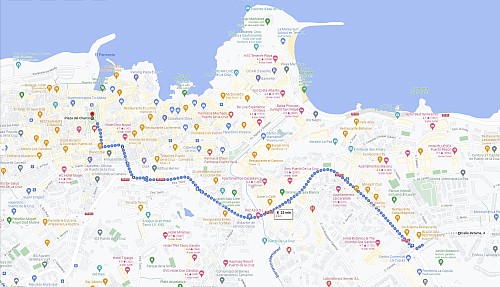 |
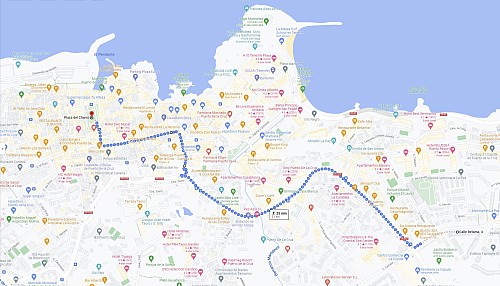 |
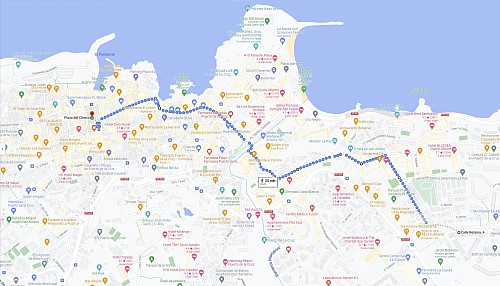 |
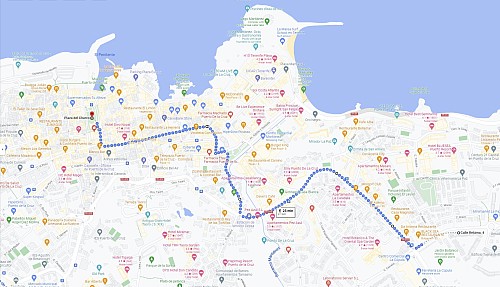 |
We took these so frequently that I got to know them quite well. For example, some of them had colorful characters we'd see repeatedly, such as a guy who would hang out with his flock of parrots on the steps just uphill from El Camino, near the base of the Agatha Christie steps. Also, some of them had shorthand landmarks that we would use - one such example was that at the bottom of Calle de las Damas, the street would turn into Calle San Juan, and a block or two up, at the corner of Calle Quintana there was a Perfumeria with a giant advertisement with a huge photo of Marion Cotillard, so we'd just know "okay, turn left at Marion Cotillard to get to Plaza de Charco." Also, with all of these routes, they all had a ton of stairs, and we walked them so frequently that eventually I committed to memory the number of stairs, e,g., whether they were odd or even. For example, the set of stairs on the Agatha Christie steps that has the "Poirot Investigates" stair is even, but the rest are odd. Canary Relax has videos walking the Casa Antigua route (starting from the Carretera around the barranco, at the 7 minute mark) and for the Agatha Christie route (starting from Mirador La Paz), shown below to help envision these routes in more detail. From experience, they're very accurate depictions of what we experienced regularly.
Most days lunch was our big meal, and for dinner we’d have at most some small tapas such as cured meat, olives, cheeses, etc. We went out of our way to try as many restaurants as possible, attempting to not repeat too many places too soon, as we had no idea what we’d like best and want to repeat. The only places we didn't really have any interest in eating were 1) at the Chinese restaurants, because their ratings were all uniformly mediocre, and 2) at the restaurants in Plaza de Charco, which were overpriced and catered to a lot of tourists. There was one guy at the northwest corner of Plaza de Charco, at a restaurant called Track I think, who would ask every time we walked by if we wanted to come in; he always asked politely, and we always declined politely. Depending on how far we walked to lunch, and how long we stayed there, sometimes we wouldn’t be back until 15:00 or 16:00. We’d normally have half a liter, or sometimes a full liter, of wine at lunch. For whatever reason, a bottle (3/4 of a liter) was hardly ever an option, so we’d either have a little less or a little more than that. While it varied from place to place, on average a half liter of wine cost about €8 and a liter cost about €15. The floor of the restaurants was “good”, with most places being “very good” to “excellent.”
After lunch, we’d go back to the house and let the dogs out to sun and enjoy the lawn, and chill out for a bit. Pig would invariably check for other dogs out his "window" at the bottom of our front gate, or in the small window between our yard and the neighbors' yard. Lola would mostly just sleep. Several times a week I would enjoy a siesta on one of the lawn chairs outside, or on the bed inside. We’d each listen to podcasts, do our homework, take some Duolingo lessons, futz around on the internet, nothing too stressful. I would've gone over to the botanic garden regularly, but 1) they didn't have anything akin to a yearly pass, and even at €2 a pop (the resident price), that would have added up quickly, and 2) almost immediately after us moving in, they closed for renovations, so I couldn't go even if I wanted to. So we just enjoyed the plants from our side of the wall. Our Spanish homework was never too difficult or too long. Usually in the afternoon Mt Teide would get covered with clouds, presumably from evaporation as the sun in the morning heated up everything on the slopes. In the early evening sometimes I would take a walk just to get some exercise in (the photos below are of one such walk, taking the "scenic route" along Carretera Este from La Paz into town on one of the few days La Palma was visible in the distance). A couple times I actually went out for a run, which I don't think I'd ever done before in my life. Tenerife is in the same time zone as the UK, but is quite a bit west of there, so the sun rises a bit later and sets a bit later. It’s not exactly Rapa Nui in terms of late sunrises and late sunsets, but I was a big fan of the late sunrise and sunset. At night we usually wouldn't eat a big dinner, but instead have some tapas (cured meat, cheese, olives, peppers, etc.), just enough to make sure our stomachs weren't growling.
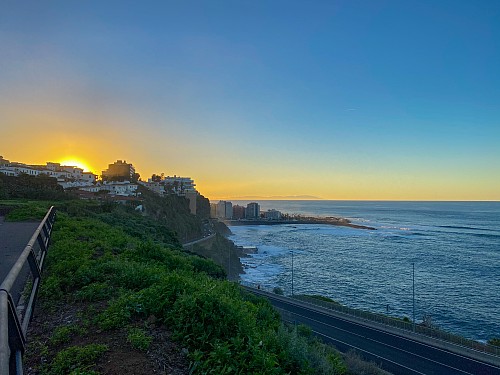 |
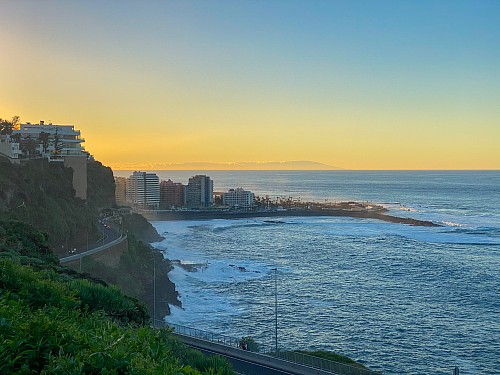 |
While we had local TV channels in the living room, we barely watched it. If we watched anything, it was something on Netflix or YouTube on the Roku that we brought. I watched a lot of Brooklyn 99, which I’d never really watched in the US. It was the middle of the NBA season, and I had the NBA app on the Roku, but the games started at 00:00 and went until around 06:00, so I didn’t really watch any NBA games live unless I woke up in the middle of the night. So I would watch sped-up replays of games I was interested in early in the morning (if I was up early enough) or after getting back from lunch. Having no blackouts, and no commericals, was really nice. The app also fortunately has a feature that can disable scores, so I wouldn’t know who won before watching. I also figured out how to stream German television that was airing the NFL playoffs, by using VPN to spoof a German location. I watched the Super Bowl live, which started at around 23:30 and went until past 03:00. The next morning, in Spanish class, I was a bit out of it, and Sandra noticed. She asked how I was, and I answered "tengo una resaca" (I have a hangover).
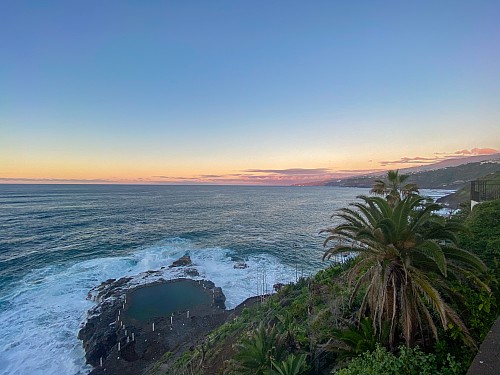 |
 |
Because the grocery store was so close, and indeed in the same spot as our Spanish classes, we’d just buy whatever we needed when we needed it, and never really came home with more than one or two bags of groceries. I'd bought a wheeled cart to transport groceries (I saw tons of people using them), but if we had just one or two bags using the cart was unwarranted. Because all the restaurants were so good, and so inexpensive, there really wasn’t much need for us to cook for ourselves. Basically, whatever we spent on lunch was over 50% of our daily discretionary spending. Because we didn't cook very much, it was really easy to keep the house clean, as it was basically just sweeping up dog hair, and there wasn't even that much dog hair since the dogs were outside much of the time. Laundry was pretty easy, except for a hiccup the first time. We stared at a bunch of cleaning supplies at Tu Trebol, and bought something that we thought was detergent, but actually must have been bleach, and Lola's black and white Barkertime became a charcoal and white Barkertime. We figured if that was the biggest issue to come from our cruddy Spanish, we could live with that.
So, this was our normal routine. Most days the first month followed this basic routine, but there were a couple days that stood out. On the 6th, we had to port our phones to Google Voice, as it had been a month since I left the US, and my roaming package was at an end. We were pretty sure we’d figured out everything we needed to do, and the order we needed to do things in, but we needed Heidi to put her phone on a new plan because once we ported our lines, our AT&T plan would immediately cease to exist, and she was on our family plan. She fortunately was able to do this without any serious problems. Once ported, we still had our US numbers, but only over data, either wi-fi or our Spanish Vodafone prepaid line. We could still text with our US numbers, but only over iMessage (for other Apple users) or Google Voice (for everyone else). But at least we still had our US numbers and didn’t need to give everyone our new Spanish numbers.
Also on the 6th, my chest still wasn’t feeling right, and I did some research to see what might be the cause. Nothing was an exact match, but a couple worrying things did seem kind of close – lung cancer and thyroid cancer. I wasn’t worried so much because these were serious health issues (although they were), but more because I had family history of both of those, so the chances weren't as remote as they ordinarily would have been. So I looked on the Sanitas website to see if they had any pulmonary specialists on Tenerife, and specifically pulmonary specialists who spoke English. They did, and then there was a search to make an appointment, so I did, for two days later, Monday the 8th. The whole process took less than an hour. Just like the American healthcare system, right?
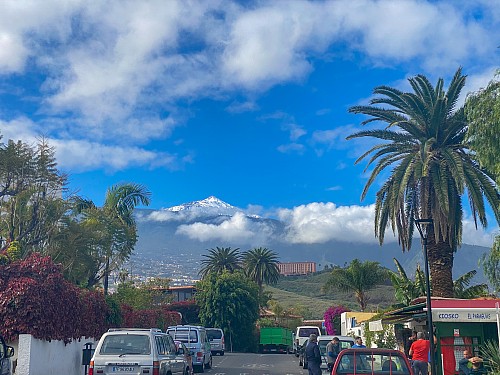 |
 |
Crystal went with me into Santa Cruz on the 8th. We left class a little early, and caught the 103 bus into Santa Cruz. Because it was the middle of the day, the bus ride wasn’t too long, only about 35 minutes or so. To use the bus we downloaded the TITSA app, and then loaded our account with money, which we could use our credit card for. On the bus, at boarding, we would activate our day pass ticket, and we’d take a picture of the QR code on the bus, which would then debit the amount from our account. It was all very 21st century. Everyone on the bus was wearing masks, and no one was bitching about it, either. The bus had monitors indicating what the next stop was, and there were buttons by which people could indicate they wanted to stop at the next stop. It wasn’t entirely clear, but we think if no one pressed the button, the bus driver just skipped that station. [We later determined there were buttons at the stations as well, so the driver would know someone was waiting.]
Once in Santa Cruz, we got off at the main bus station, in the southeast part of town, not far from the main auditorium that vaguely resembles the Sydney Opera House. We walked north through town, which was notably warmer than Puerto, and turned east to go through Parque García Sanabria, which was full of large trees and palms. Hospiten Rambla was just a couple blocks from there, and I got there a good amount before my appointment. At check-in, I used what little Spanish I knew to indicate I had an appointment, and with which doctor. This worked okay, but then they asked for my insurance card, which I didn’t have yet. I had my policy number and other contact information from Sanitas, however, and after a lengthy wait (and a shift change of workers at 15:00), they got everything squared away. I got an English-speaking escort up to where my doctor was, and the doctor asked me some questions, told me not to worry too much, and then ordered a chest x-ray, which I went downstairs for. I then went back upstairs to see the doctor again, and she said it looked normal, but that to be 100% sure, I’d need a CT scan, which I expected based on my online research. [I do my own research. Too soon?] I asked her if my insurance would cover that, given that I’d had it only for 3 months, and she said probably, but that in any case I could just pay cash if need be. I asked how much, and she said “not too much, maybe €100-150.” I tried to keep my jaw from dropping. We arranged for a CT scan appointment, and then I was on my way. I think I was at the hospital maybe 90 minutes total, including about 30 minutes where they tried to figure out my insurance card. And this was all with no-copay or deductible.
On the way back to the bus station, we checked out the parque a little bit, got some ear medicine for Crystal at a local pharmacia, and checked out Santa Cruz a little bit. Our cruise ship had docked at Santa Cruz in April 2019, but we hadn’t really explored the town. The one good Mexican restaurant from Puerto, Taquería el Wero, had moved to Santa Cruz in 2020, but we saw it was not open on Mondays or Tuesdays, so we missed out on that. I was definitely craving some Mexican food, and realized we might need to just make it ourselves. We did get some tasty Venezuelan food and drink at an outdoor place not far from the bus station before heading back home. On 13 February, I had another Zoom call for Amateur Traveler, and before I said anything, a couple people asked about the dogs, and whether they were okay, and that made me feel pretty good that others were interested in their well-being. The fact they remembered after a month warmed my heart.
14 February was Valentine’s Day, which isn’t a holiday in Spain, but it was a nice day outside so we decided to have a nice lunch anyway. Sundays were the only day that Edelweiss, a restaurant near our place with a rooftop terrace, was open for lunch, so we tried to go there so we could have a view of Teide, but they were completely full. So instead, we went over by the La Paz lookout, and specifically just to the east of the lookout, where there were some restaurants and coffee shops on Paseo de la Costa. One of them, Bellamar, had outdoor tables with views over Lago Martianez and Playa Martianez, not to mention all of downtown plus Mt Teide. It required having the sun beating down on my face and in my eyes, but it was worth it for the view. I don’t remember any of the food being particularly memorable, but being able to eat outside on a gorgeous day in mid-February is something that’s usually not possible even in San Diego.
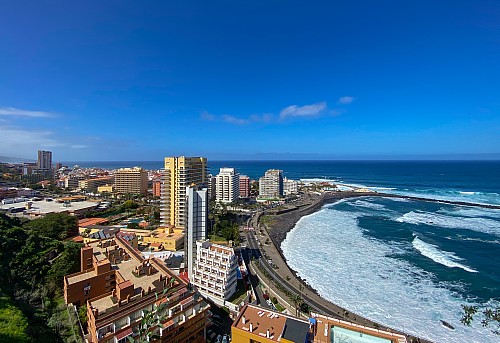 |
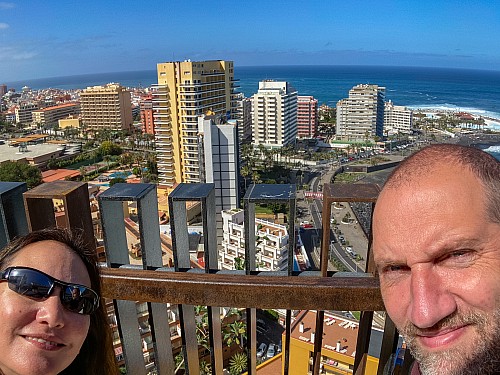 |
15 February was our first introduction to Calima, the dry wind pattern that reminded us of Santa Anas in Southern California. The prevailing tradewinds on Tenerife are typically from the north; using a clockface to explain, the winds usually come from 1:00 or 1:30 and blow towards 7:00 or 7:30. However, every so often the winds come from the south or the east, i.e., the Sahara desert, which is only about 200 miles away. When the winds come from there, the humidity drops, the temperature increases, and depending on how strong the Calima, sandstorms can hit the island. Since Puerto is on the north side of Mt Teide, it doesn’t (usually) get as much wind or as much sand as the southeast side of the island.
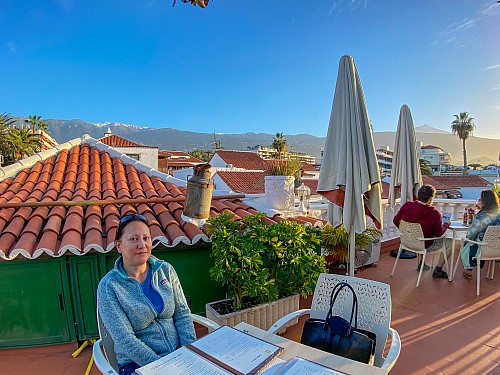 |
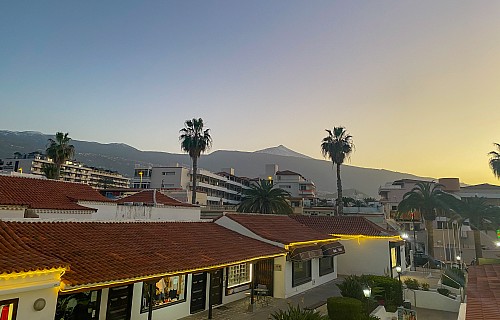 |
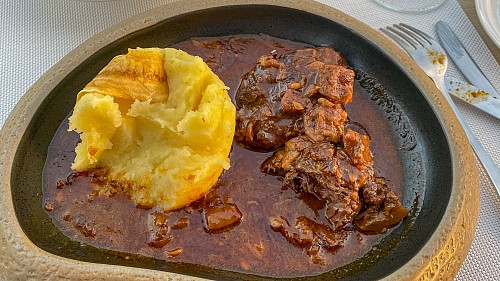 |
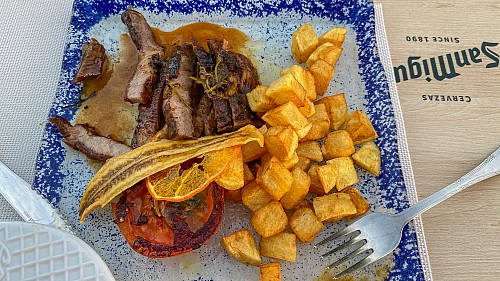 |
Without being told we were having a Calima, it was pretty obvious to me. That morning, it was noticeably drier and warmer, and the sky wasn’t as blue as normal. In class, Sandra explained Calima to us, and mentioned there had been a bad one in 2020 that had forced the cancellation of Carnaval. [It would have occurred just prior to COVID shutdowns, basically like what happened in New Orleans, so it was probably for the best that the Calima was so strong.] In the afternoon, there were no clouds in the sky, which was definitely unusual, and so when it got to be dinner time, we actually went out to dinner for once, at Edelweiss, on their rooftop terrace (photos above, in case it wasn't obvious). So we got our view of Mt Teide, but ironically at dinner instead of lunch, go figure. I had been there before Crystal arrived, and had some goulash that was excellent, but we had not been there together yet. Several things looked great, and we had a hard time choosing, but we chose wisely. As we texted Heidi, “[we had] two of the best pork dishes we’ve ever had. [One was] pork cheeks in some sort of gravy, the other was cerdo secreto iberico – that was grilled (I think) but somehow had a crispy edge throughout.” So basically, we had two Valentine’s Days.
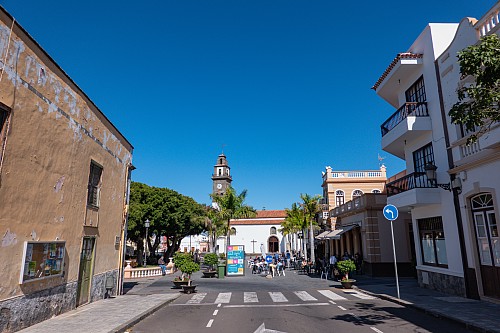 |
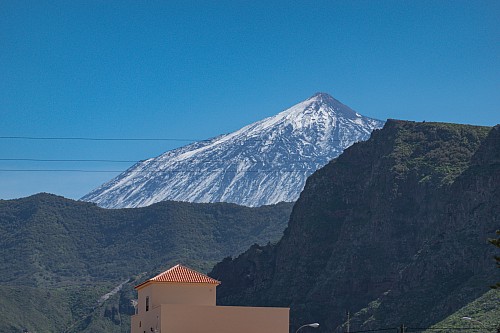 |
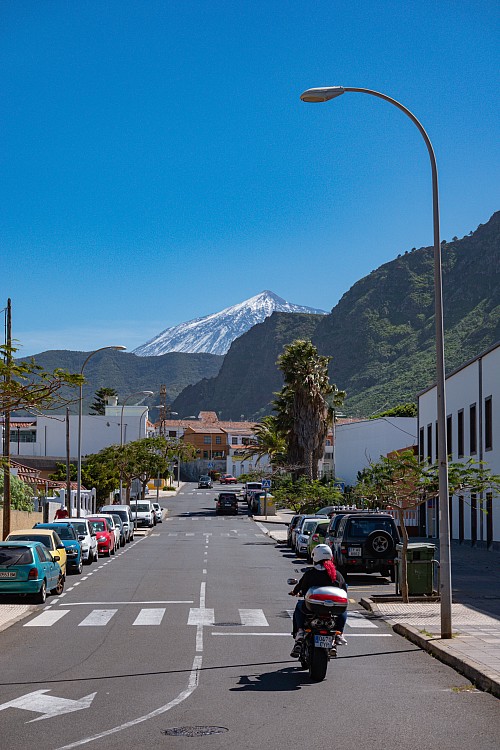 |
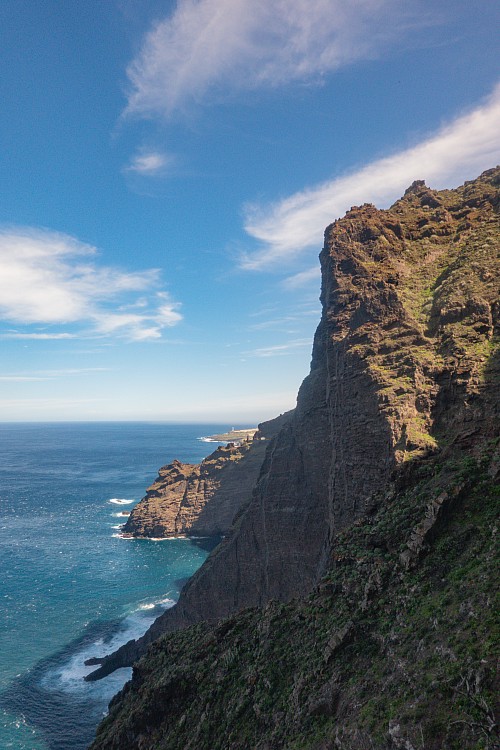 |
On February 20th, we took our first excursion out of town, putting aside the airport trips and the trip to the hospital. We decided to go to Punta del Teno, the westernmost part of the island. We loaded up our 10 Euro daypass on the TITSA app again, and caught the 363 bus that went west from Puerto along the northern coast. This bus stopped a lot more than the bus to Santa Cruz, seemingly a couple of times every mile. The bus went southeast from downtown Puerto, up through La Paz and into La Orotava, then west through La Orotava, the southwest part of Puerto, and then Los Realejos. From there it continued more or less along TF-5 and frontage roads, through San Juan de la Rambla and towards Icod. In Icod there was a small bus station, but we didn’t get off there. The bus continued west through Garachico, which looked gorgeous, and finally ended in Buenavista del Norte. The station there had stalls for about 5 or 6 buses. One of the stalls was for a special bus that went from the station even further west, to Punta del Teno. That road, at least during the weekends, is closed to the public.
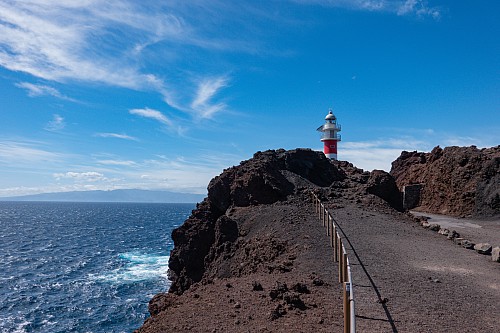 |
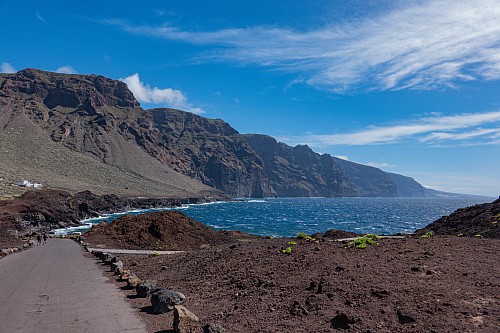 |
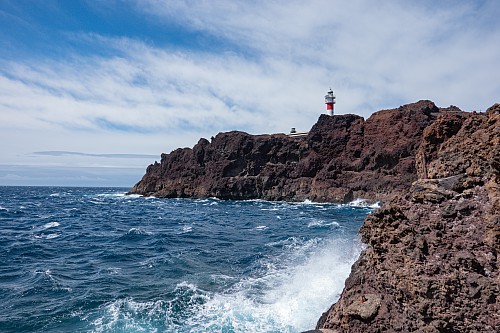 |
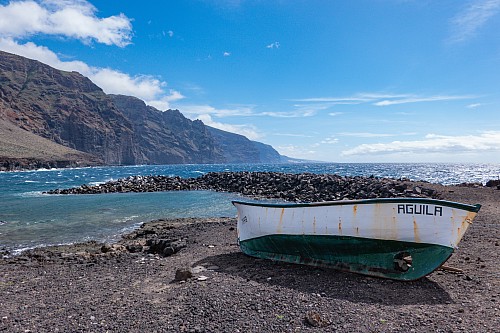 |
We walked around Buenavista del Norte for a little bit, and got some very inexpensive (but pretty good) wine at a bar on the main square, then walked back to the bus station. Right near the station there was a place grilling meat, Asador El Cardón, which smelled great, but we couldn’t find an entrance, so we wondered if maybe it was just doing takeout or delivery or something. The small bus to Punta del Teno was rather picturesque, on a winding road with cliffs and ocean all around. [Someone later told us that this stretch of road was used in one of the Fast & Furious movies, in an opening scene.] We slowly made our way towards the faro (lighthouse) at the end of the road. The bus dropped us off there, and when we got out it was incredibly windy and accordingly colder than we were expecting. We walked around the area, including up to the gate to the faro, down to the ocean just south of the faro, past a small bay with some tiny fishing boats. To the south we could see, or thought we could see, Los Gigantes, some famous cliffs that you can see on boat tours from the tourist areas in the south. Looking to the south, there was a lot of nothing, and then you could see all of the tourist areas, and it was very stark.
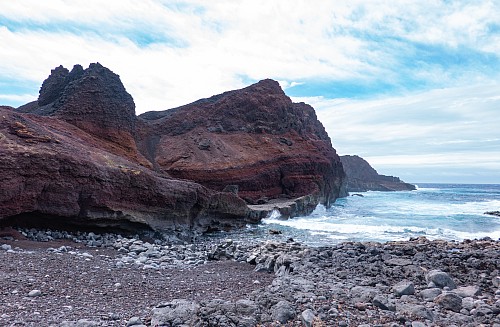 |
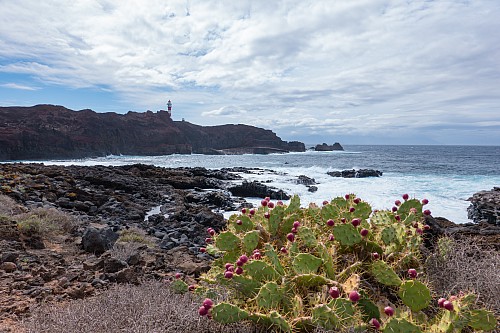 |
 |
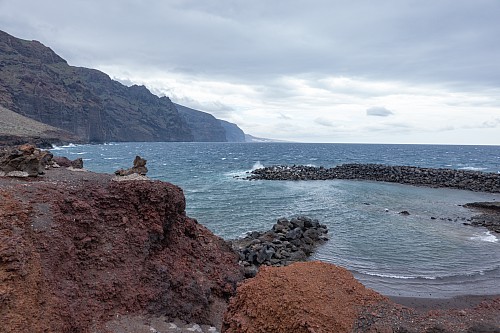 |
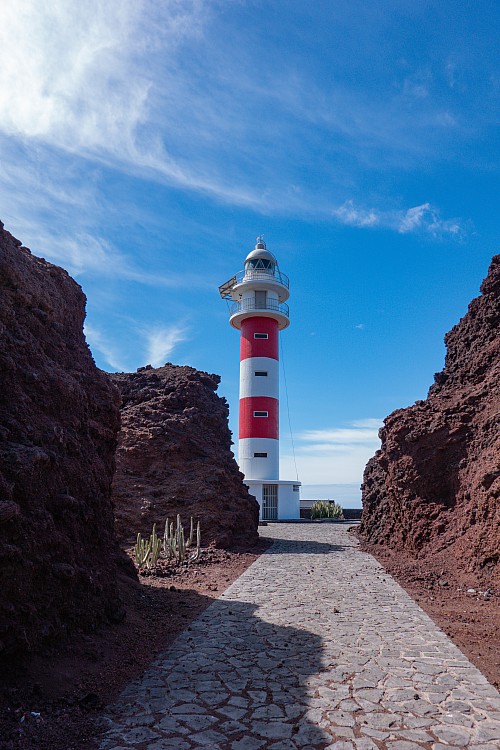 |
We had to wait an hour for the next bus to come back, and the last 15-20 minutes the weather turned on us. It wasn’t quite raining, but it was far from sunny, and the wind was so strong we legitimately had to be careful about not being blown over. We found a somewhat protected area and just hung out until the bus came by. We felt bad for the people who didn’t make the bus, as they’d have to wait another hour, and the weather didn’t seem like it would be improving. Back in Buenavista del Norte, it was far less windy than at Punta del Teno, and we didn’t have to wait long for the 363 bus to take us back to Puerto. The views made the excursion well worth it, even if the wind was a sight to behold. Well, at least we got a story out of it. Back in town, we got some Pisco sours (and food, too) at a Peruvian restaurant right near the bus station, then made our way home on foot.
| Previous Entry |